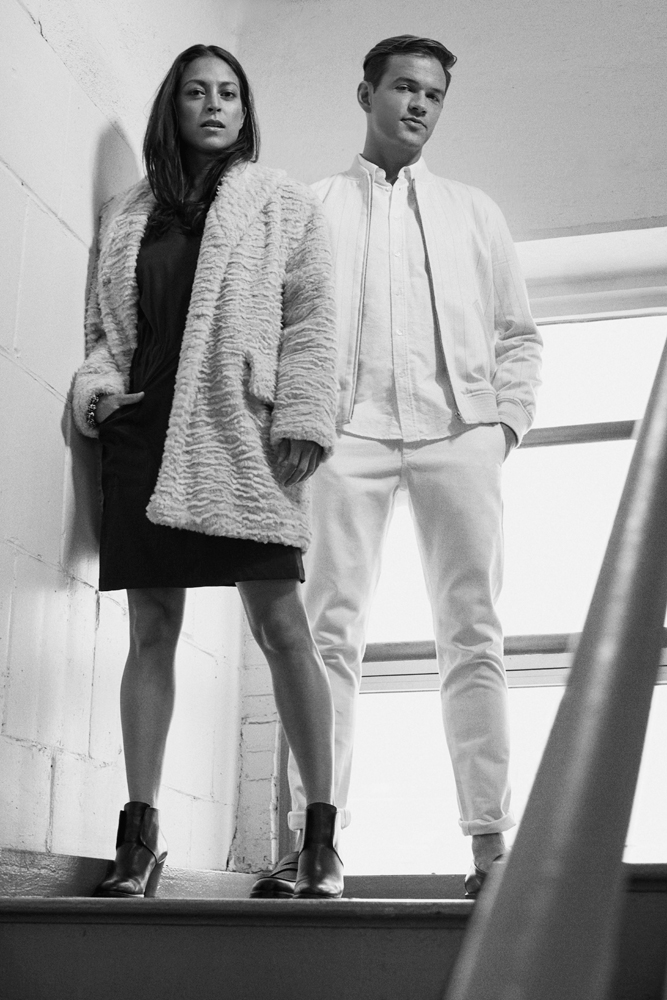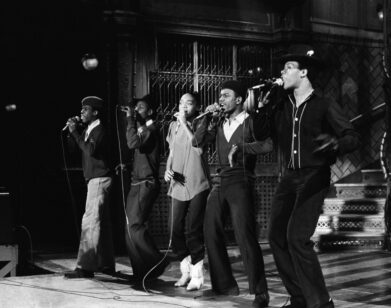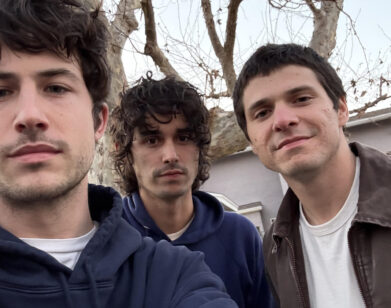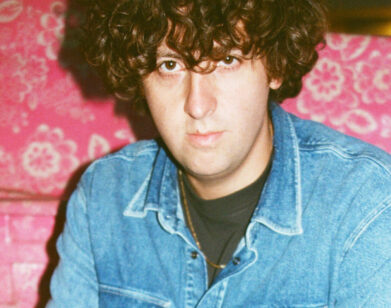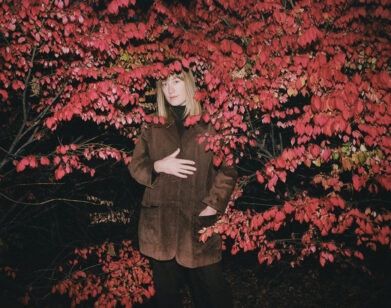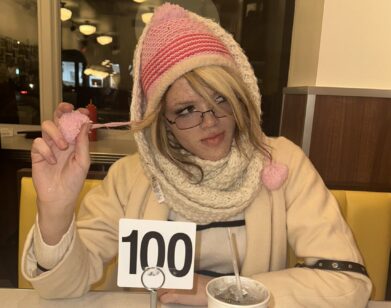St. Lucia’s Mind Over Matter
PATTI BERANEK AND JEAN-PHILIP GROBLER (ST. LUCIA) IN NEW YORK, DECEMBER 2015. PHOTOS: HANS NEUMANN. STYLING: JULIAN JESUS. HAIR: THOMAS DUNKIN. MAKEUP: MARCO CASTRO. RETOUCHING: DENIZ KARAVELIOGLU.
The smell of incense hangs thick in the air when we visit Jean-Philip Grobler’s Williamsburg apartment to discuss his new album as St. Lucia, Matter. Grobler and his wife Patti Beranek, also a recording member of St. Lucia, are between travels: they have just returned from playing a few private DJ sets on the West Coast and are days from jetting off for the holidays. Grobler, however, is already visibly excited about the prospect of touring and getting back into the recording studio.
There is plenty to digest in Matter, St. Lucia’s follow-up to its 2013’s When the Night,. If When the Night was St. Lucia’s id, Matter is its superego-stripped back, cleaned up, and liberated from the sonic bath that enveloped and obscured many tracks on When the Night. Rife with intent, Matter most closely parallels a hybrid of New York-based producer Autre Ne Veut and indie-pop phenomenon Bleachers, making St. Lucia’s collaboration with Bleachers’ Jack Antonoff a fortuitous one. When Grobler was initially sent to Los Angeles on a co-writing trip, though, he was reluctant. “Often the result of [co-writing] can be that the person’s artistic voice doesn’t come through as strong because they’re put in a room with people who have a stronger voice,” he explains.
So while When the Night was the product of Grobler’s own experimentation, Matter (out next week, January 29) features writing by Antonoff as well as Tim Pagnotta, and ultimately profits from the outside input. “You can’t be 100 percent selfish when you’re working with somebody else,” Grobler says, adding that it results in “more interesting and intriguing” music than solo material. Now, he has planned further collaborations with Norwegian producer Lindstrøm and British DJ Alex Metric. (Grobler performs alone as a DJ, too, though he concedes that it comes less naturally and he’s plagued by occasional nerves.)
When we sit down to ask Grobler something vague about his process, he pauses, turning to Beranek and a few label representatives, “Actually, guys, sorry, would you mind if we did this alone?” he says. After they quietly recede into neighboring rooms, we speak in earnest about subjects ranging from growing up in South Africa during Apartheid to the difficulties of composing new music with a rigorous touring schedule. Additionally, Grobler walks listeners through four of the album’s tracks in the exclusive video below.
KATHERINE CUSUMANO: Could you take me through the process of making this album?
JEAN-PHILIP GROBLER: I basically work all the time. There are even songs on this record that were written before the last album came out. We started touring once When the Night came out and I realized that I needed to embrace being able to write on the road. For the last record, I had this perfect situation where my studio was a three-minute walk away, and every day I would go to the studio work on these ideas. I was living on saved-up money—that was a little bit stressful—but I had all my instruments at all times. If I had an idea, I could work on it at the highest level possible. But once we started touring, I decided to create a really good laptop recording situation and to learn how to write that way, rather than have the perfect stuff around. A lot of this album was written and demoed on my laptop on my lap in a van driving to wherever on tours. About this time last year, I went to the studio with Chris Zane, and we spent six or seven months on and off recording.
CUSUMANO: You collaborated a lot more on this album than on previous stuff. Were you ever self-conscious?
GROBLER: I try to not be self-conscious in my writing process. I think it’s important to just be in your subconscious mind—at least when you’re starting an idea. But normally when I’m writing, in the beginning I don’t think of lyrics at all. I’m just improvising. A lot of the people I was writing with think a lot more about lyrics and a lot more about the details from the beginning. That kind of thinking made me a little self-conscious because I was suddenly having to judge what I was doing early on in the process. But I realized if you keep working at that, it turns into something good. For example, “Dancing on Glass,” when we started writing it, I was like, “This just sounds like a terrible St. Lucia cover.” That was the first writing session that I had, and at the end of the day I was like, “I’m not coming back.” The process felt so thought through. It didn’t feel like it was flowing. We were really writing every single section, and that felt so difficult and unintuitive to me. But then after giving it a night, I was suddenly like, “This is actually really good.” The second day ended up being great. It was completely the reverse of the way I normally experience it.
CUSUMANO: How do your songs change between recording ideas and then going into the studio? What changes when you get everyone in the room together?
GROBLER: When I start working on an idea, I immediately record without judging it. With the first album, the demoing process and the recording process were the same, which made it more difficult sometimes. For example, “We Got It Wrong” was recorded five completely separate times from start to finish. With this record, the tracks were demoed to an extent, and then I started working with Chris. We went into the studio and we only have this finite amount of time to work on it. You have to be a lot more concise, which sounds like it’s limiting your creativity but when there’s no limit to the ideas you can come up with, you can just get lost in that. The moment you put a cap on that, you can be a lot more efficient with what you’re doing. I think that’s what changes—you go from a subconscious space to a concrete, working environment.
CUSUMANO: There are a lot of artistic movements that really thrive on constraint—writing, visual art. Having something that you’re working within is a lot more liberating for some artists. I want to rewind a little, how did you start making music?
GROBLER: I’ve been making music for as long as I can remember. I would, as a kid, just sing little ideas or be making something. I went to this boy’s choir school when I was growing up, and I think that the first time that I consciously started making music was when this one kid joined our class. He was an amazing pianist and would come up with all these ideas. I’ve always had a really competitive side, so I saw him doing that, and was like, “I have to try writing songs as well.” We started a band with him—my first band was called Savanna Dream. I was, like, 11 at the time. That turned into a boy-band sort of thing that was really influenced by Boyz II Men. That turned into a rock band as I started getting more and more into Radiohead and rock music. I was very conceptual about what I was doing; I had the first five albums planned out, and all the songs on every album, and the artwork. I always had these ambitious musical projects in mind.
CUSUMANO: At what point did you realize that it was what you wanted to keep doing?
GROBLER: There were times when I would suddenly realize making music is a crazy pipe dream. I would see bands that did super well in South Africa still struggling to survive, or even people on the international level who are doing well but financially can’t really support themselves. There were times where my mom would be like, “I support your dream but maybe you should think of something to fall back on?” But within a couple of months, I would always come back to music. I would be like, “This is what I want to do and I’m willing to accept the consequences.” I was also always interested in the aesthetic realm—architecture and that kind of stuff—but music was my first love.
CUSUMANO: I was thinking of the cover art for Matter and also the video for “Dancing On Glass.” What role does visual art play for you in music?
GROBLER: It plays a really, really big role. When I’m writing, those ideas are seldom inspired by music itself. I won’t often listen to an artist and come up with an idea. A lot of my ideas come from McNally Jackson bookstore. One of my favorite things to do is just go there and look through architecture books and interior design books. Something about the aesthetics of space and beautiful images works with my brain. Films as well—I’m a huge Hayao Miyazaki fan. He might be my favorite director of all time—the beauty that he sees in the world and the attention to detail. I try and focus on that while making music: trying to use as many real instruments as possible, have it feel as tactile and tangible as possible. I think that layers in music, whether it’s layers juxtaposing emotions and feelings or layers of texture, make for a more interesting product.
CUSUMANO: South Africa has a very thriving both visual art culture and music culture. I think the prototypical western interpretation of South Africa is Graceland, but there’s a lot more to it. How did growing up there impact your own composition?
GROBLER: When I was growing up, it was still during Apartheid, so the country was very shielded from the outside artistic world. Anything that was too subversive was basically banned. All the music that we got from outside of South Africa was the poppiest, least subversive music that you could get. I feel like kids that grew up in New York City or in L.A. were exposed to all these subcultures and subgenres, whereas I was only exposed to the poppiest of pop music so I never had this negative connotation towards pop music. That’s not South African music having an effect on me, but just how international music was filtered through South Africa affected me. It gave me a not-negative connotation towards pop music growing up.
What I love about African-African music is how unselfconscious it is in so many ways. The music that I listen to the most is probably world music, whether it’s from African or South America or all over. When I listen to music from our scene, there’s just so much thought and pretense and so many things that you have to think about to know how to judge that music. World music evokes a feeling. You don’t have to think about the scene that it comes from. When I was developing St. Lucia—around 2008, 2009, at the peak of Pitchfork culture—what was considered cool was being as alienating to your audience as possible. Now I feel like we’ve swung completely to the other side; pop is the cool thing. But trying to be really dark and alienating just felt exhausting to me, so I started going back to the music that I grew up with, whether it was African music or pop music. It took me away from being overly self-conscious about what I was doing. I was like, “I should write from a place of complete intuition.” I’m not trying to make something that will appeal specifically to people who like this cool subgenre. It’s more that this is an idea that excites me right now.
CUSUMANO: I’m curious how much growing up during Apartheid impacted your day-to-day life?
GROBLER: When I think back, I felt like I had the life that a lot of white American kids grew up with in the suburbs in the States. I started noticing, as Apartheid’s grip weakened, that we had more and more black kids at school; I had more and more black friends. But I never really saw a separation between myself and the black kids at school. I think I was just too young to even understand what was going on. When I was still living in South Africa, there was still so much racial tension. I think that racially, people think about things a lot less progressively over there than they do over here. The racial conversation in the States is so multifaceted and multilayered. Obviously it’s not always a positive conversation, but it’s just so much more detailed than it was when I was growing up in South Africa.
MATTER WILL BE RELEASED FRIDAY, JANUARY 29 VIA COLUMBIA RECORDS. FOR MORE ON ST. LUCIA, VISIT THE BAND’S WEBSITE.

